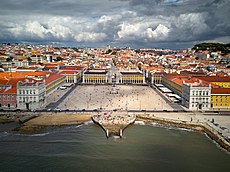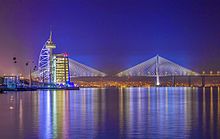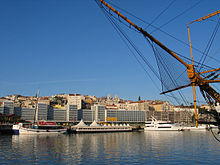
Lisbon (/ˈlɪzbən/; Portuguese: Lisboa) is the capital and the largest city of Portugal, with an estimated population of 552,700 within its administrative limits in an area of 100.05 km². Its urban area extends beyond the city's administrative limits with a population of around 2.7 million people, being the 11th-most populous urban area in the European Union. About 3 million people live in the Lisbon Metropolitan Area (which represents approximately 27% of the country's population). It is continental Europe's westernmost capital city and the only one along the Atlantic coast. Lisbon lies in the western Iberian Peninsula on the Atlantic Ocean and the River Tagus. The westernmost areas of its metro area form the westernmost point of Continental Europe, which is known as Cabo da Roca, located in the Sintra Mountains.
Lisbon is recognised as a alpha-level global city by the Globalization and World Cities (GaWC) Study Group because of its importance in finance, commerce, media, entertainment, arts, international trade, education and tourism. Lisbon is the only Portuguese city besides Porto to be recognised as a global city. It is one of the major economic centres on the continent, with a growing financial sector and one of the largest container ports on Europe's Atlantic coast. Additionally, Humberto Delgado Airport served 26.7 million passengers in 2017, being the busiest airport in Portugal, the 3rd busiest in the Iberian Peninsula and the 20th busiest in Europe, and the motorway network and the high-speed rail system of Alfa Pendular links the main cities of Portugal (such as Braga, Porto and Coimbra) to Lisbon. The city is the 9th-most-visited city in Southern Europe, after Rome, Istanbul, Barcelona, Milan, Venice, Madrid, Florence and Athens, with 3,320,300 tourists in 2017. The Lisbon regioncontributes with a higher GDP PPP per capita than any other region in Portugal. Its GDP amounts to 96.3 billion USD and thus $32,434 per capita. The city occupies 32nd place of highest gross earnings in the world. Most of the headquarters of multinationals in the country are located in the Lisbon area. It is also the political centre of the country, as its seat of Government and residence of the Head of State.
Lisbon is one of the oldest cities in the world, and one of the oldest in Western Europe, predating other modern European capitals such as London, Paris and Rome by centuries. Julius Caesar made it a municipium called Felicitas Julia, adding to the name Olissipo. Ruled by a series of Germanic tribes from the 5th century, it was captured by the Moors in the 8th century. In 1147, the Crusaders under Afonso Henriques reconquered the city and since then it has been a major political, economic and cultural centre of Portugal. Unlike most capital cities, Lisbon's status as the capital of Portugal has never been granted or confirmed officially – by statute or in written form. Its position as the capital has formed through constitutional convention, making its position as de facto capital a part of the Constitution of Portugal.
Geography
Lisbon has a Mediterranean climate (Köppen: Csa) with mild, rainy winters and warm to hot, dry summers. The average annual temperature is 17.4 °C (63.3 °F), 21.3 °C (70.3 °F) during the day and 13.5 °C (56.3 °F) at night.
In the coldest month – January – the highest temperature during the day typically ranges from 10 to 18 °C (50 to 64 °F), the lowest temperature at night ranges from 3 to 13 °C (37 to 55 °F) and the average sea temperature is 16 °C (61 °F). In the warmest month – August – the highest temperature during the day typically ranges from 25 to 32 °C (77 to 90 °F), the lowest temperature at night ranges from 14 to 20 °C (57 to 68 °F) and the average sea temperature is 20 °C (68 °F).
Among European cities with a population above 500,000, Lisbon has one of the warmest winters (less than Valencia or Málaga) and one of the mildest night time temperatures, from an average of 8.3 °C (46.9 °F) in the coldest month, and 18.6 °C (65.5 °F) in the warmest month. The minimum temperature recorded in Lisbon was −1.2 °C (30 °F) in February 1956 and −1 °C (30 °F) in January 1985. The maximum temperature recorded in Lisbon was 42 °C (108 °F) on 1 August 2003.
Sunshine hours are about 2,800 per year, from an average of 4.6 hours of sunshine duration per day in December to an average of 11.4 hours of sunshine duration per day in July.
Physical geography
The westernmost part of Lisbon is occupied by the Parque Florestal de Monsanto (English: Monsanto Forest Park), a 10 km2 (4 sq mi) urban park, one of the largest in Europe, and occupying ten percent of the municipality.
The city occupies an area of 100.05 km2 (39 sq mi), and its city boundaries, unlike those of most major cities, coincide with those of the municipality.[45] The rest of the urbanised area of the Lisbon Metropolitan Area, known generically as Greater Lisbon (Portuguese: Grande Lisboa), extends to the city of Setúbal and includes several administratively defined cities and municipalities, such as Amadora, Queluz, Agualva-Cacém, Odivelas, Loures, Sacavém, Almada, Barreiro, Seixal and Oeiras.
Civil parishes
The municipality of Lisbon included 53 freguesias (civil parishes) until November 2012. A new law ("Lei n.º 56/2012") reduced the number of freguesias to the following 24:
- Ajuda
- Alcântara
- Alvalade
- Areeiro
- Arroios
- Avenidas Novas
- Beato
- Belém
- Benfica
- Campo de Ourique
- Campolide
- Carnide
- Estrela
- Lumiar
- Marvila
- Misericórdia
- Olivais
- Parque das Nações
- Penha de França
- Santa Clara
- Santa Maria Maior
- Santo António
- São Domingos de Benfica
- São Vicente
Bairros
Locally, Lisbon's inhabitants may commonly refer to the spaces of Lisbon in terms of historic Bairros de Lisboa (neighbourhoods). These communities have no clearly defined boundaries and represent distinctive quarters of the city that have in common a historical culture, similar living standards, and identifiable architectural landmarks, as exemplified by the Bairro Alto, Alfama, Chiado, and so forth.
Alcântara
Although today it is quite central, it was once a mere suburb of Lisbon, comprising mostly farms and country estates of the nobility with their palaces. In the 16th century, there was a brook there which the nobles used to promenade in their boats. During the late 19th century, Alcântara became a popular industrial area, with lots of small factories and warehouses.
In the early 1990s, Alcântara began to attract youth because of the number of pubs and discothèques. This was mainly due to its outer area of mostly commercial buildings, which acted as barriers to the noise-generating nightlife (which acted as a buffer to the residential communities surrounding it). In the meantime, some of these areas began to become gentrified, attracting loft developments and new flats, which have profited from its river views and central location.
The riverfront of Alcântara is known for its nightclubs and bars. The area is commonly known as docas (docks), since most of the clubs and bars are housed in converted dock warehouses.
Alfama
The oldest district of Lisbon, it spreads down the southern slope from the Castle of São Jorge to the River Tagus. Its name, derived from the Arabic Al-hamma, means fountains or baths. During the Islamic invasion of Iberia, the Alfama constituted the largest part of the city, extending west to the Baixa neighbourhood. Increasingly, the Alfama became inhabited by fishermen and the poor: its fame as a poor neighbourhood continues to this day. While the 1755 Lisbon earthquake caused considerable damage throughout the capital, the Alfama survived with little damage, thanks to its compact labyrinth of narrow streets and small squares. It is an historical quarter of mixed-use buildings occupied by Fado bars, restaurants, and homes with small shops downstairs. Modernising trends have invigorated the district: old houses have been re-purposed or remodelled, while new buildings have been constructed. Fado, the typically Portuguese style of melancholy music, is common (but not obligatory) in the restaurants of the district.
Mouraria
The Mouraria, or Moorish quarter, is one of the most traditional neighborhoods of Lisbon, although most of its old buildings were demolished by the Estado Novo between the 1930s and the 1970s. It takes its name from the fact that after the reconquest of Lisbon, the Muslims who remained were confined to this part of the city. In turn, the Jews were confined to three neighbourhoods called "Judiarias"
Bairro Alto
Bairro Alto (literally the upper quarter in Portuguese) is an area of central Lisbon that functions as a residential, shopping and entertainment district; it is the centre of the Portuguese capital's nightlife, attracting hipster youth and members of various music subcultures. Lisbon's Punk, Gay, Metal, Goth, Hip Hop and Reggae scenes all find a home in the Bairro with its many clubs and bars that cater to them. The crowds in the Bairro Alto are a multicultural mix of people representing a broad cross-section of modern Portuguese society, many of them being entertainment seekers and devotees of various music genres outside the mainstream, yet Fado, Portugal's national music, still survives in the midst of the new nightlife.
Baixa
The heart of the city is the Baixa or city centre; the Pombaline Baixa is an elegant district, primarily constructed after the 1755 Lisbon earthquake, taking its name from its benefactor, Sebastião José de Carvalho e Melo, 1st Marquis of Pombal, who was the minister of Joseph I of Portugal (1750–1777) and a key figure during the Portuguese Enlightenment. Following the 1755 disaster, Pombal took the lead in rebuilding Lisbon, imposing strict conditions and guidelines on the construction of the city, and transforming the organic street plan that characterised the district before the earthquake into its current grid pattern. As a result, the Pombaline Baixa is one of the first examples of earthquake-resistant construction. Architectural models were tested by having troops march around them to simulate an earthquake. Notable features of Pombaline structures include the Pombaline cage, a symmetrical wood-lattice framework aimed at distributing earthquake forces, and inter-terrace walls that were built higher than roof timbers to inhibit the spread of fires.
constructed after the 1755 Lisbon earthquake, taking its name from its benefactor, Sebastião José de Carvalho e Melo, 1st Marquis of Pombal, who was the minister of Joseph I of Portugal (1750–1777) and a key figure during the Portuguese Enlightenment. Following the 1755 disaster, Pombal took the lead in rebuilding Lisbon, imposing strict conditions and guidelines on the construction of the city, and transforming the organic street plan that characterised the district before the earthquake into its current grid pattern. As a result, the Pombaline Baixa is one of the first examples of earthquake-resistant construction. Architectural models were tested by having troops march around them to simulate an earthquake. Notable features of Pombaline structures include the Pombaline cage, a symmetrical wood-lattice framework aimed at distributing earthquake forces, and inter-terrace walls that were built higher than roof timbers to inhibit the spread of fires.
Belém
Belém is famous as the place from which many of the great Portuguese explorers set off on their voyages of discovery. In particular, it is the place from which Vasco da Gama departed for India in 1497 and Pedro Álvares Cabral departed for Brazil in 1499. It is also a former royal residence and features the 17th–18th century Belém Palace, a former royal residence now occupied by the President of Portugal, and the Ajuda Palace, begun in 1802 but never completed.
Perhaps Belém's most famous feature is its tower, Torre de Belém, whose image is much used by Lisbon's tourist board. The tower was built as a fortified lighthouse late in the reign of Dom Manuel l (1515–1520) to guard the entrance to the port. It stood on a little island in right side of the Tagus, surrounded by water. Belém's other major historical building is the Mosteiro dos Jerónimos (Jerónimos Monastery), which the Torre de Belém was built partly to defend. Belém's most notable modern feature is the Padrão dos Descobrimentos(Monument to the Discoveries) built for the Portuguese World Fair in 1940. In the heart of Belém is the Praça do Império: gardens centred upon a large fountain, laid out during World War II. To the west of the gardens lies the Centro Cultural de Belém. Belém is one of the most visited Lisbon districts. Here is located the Estádio do Restelo, house of Belenenses.
Chiado
The Chiado is a traditional shopping area that mixes old and modern commercial establishments, concentrated specially in the Rua do Carmo and the Rua Garrett. Locals as well as tourists visit the Chiado to buy books, clothing and pottery as well as to have a cup of coffee. The most famous café of Chiado is A Brasileira, famous for having had poet Fernando Pessoa among its customers. The Chiado is also an important cultural area, with several museums and theatres, including the opera. Several buildings of the Chiado were destroyed in a fire in 1988, an event that deeply shocked the country. Thanks to a renovation project that lasted more than 10 years, coordinated by celebrated architect Siza Vieira, the affected area has now virtually recovered.
The ornate, late 18th-century Estrela Basilica is the main attraction of this district. The church with its large dome is located on a hill in what was at the time the western part of Lisbon and can be seen from great distances. The style is similar to that of the Mafra National Palace, late baroque and neoclassical. The façade has twin bell towers and includes statues of saints and some allegorical figures. São Bento Palace, the seat of the Portuguese parliament and the official residences of the Prime Minister of Portugal and the President of the Assembly of the Republic of Portugal, are in this district. Also in this district is Estrela Park, a favorite with families. There are exotic plants and trees, a duck pond, various sculptures, a children's playground, and many cultural events going on through the year, including outdoor cinema, markets, and music festivals.
Parque das Nações
 Parque das Nações (Park of Nations) is the newest district in Lisbon, having emerged from an urban renewal programme leading to the World Exhibition of Lisbon 1998, also known as Expo'98. The area suffered massive changes giving Parque das Nações a futuristic look. A long lasting legacy of the same, the area has become another commercial and higher end residential area for the city. Central to this is the Gare do Oriente (Orient railway station), one of the main transport hubs of Lisbon for trains, buses, taxis and the metro. Its glass and steel columns are inspired by Gothic architecture, lending the whole structure a visual fascination (especially in sunlight or when illuminated at night). It was designed by the architect Santiago Calatrava from Valencia, Spain. Across the street, through Vasco da Gama Mall, is Parque das Nações (Park of the Nations), site of the 1998 World Expo.
Parque das Nações (Park of Nations) is the newest district in Lisbon, having emerged from an urban renewal programme leading to the World Exhibition of Lisbon 1998, also known as Expo'98. The area suffered massive changes giving Parque das Nações a futuristic look. A long lasting legacy of the same, the area has become another commercial and higher end residential area for the city. Central to this is the Gare do Oriente (Orient railway station), one of the main transport hubs of Lisbon for trains, buses, taxis and the metro. Its glass and steel columns are inspired by Gothic architecture, lending the whole structure a visual fascination (especially in sunlight or when illuminated at night). It was designed by the architect Santiago Calatrava from Valencia, Spain. Across the street, through Vasco da Gama Mall, is Parque das Nações (Park of the Nations), site of the 1998 World Expo.The area is pedestrian-friendly with new buildings, restaurants, gardens, the Casino Lisbon, the FIL building (International Exhibition and Fair), the Camões Theatre, as well as the Oceanário de Lisboa (Lisbon Oceanarium), the second largest in the world. The district's Altice Arena has become Lisbon's "jack-of-all-trades" performance arena. Seating 20,000, it has staged events from concerts to basketball tournaments.
Conference Information Form
Dear ICRESS Participant, The program and abstract books are prepared and available in your conference account. Please complete the following form for the organization of social events, lunches, coffee breaks or airport transfer: Conference Inform...
23.01.2019
Opportunity for Second Conference Participation!
The ICRESS participants can take part as listeners for free in the sessions of the International Conference on Research in Engineering, Technology and Science (ICRETS) which will take place on February 3-7, 2019 in Lisbon, Portugal. ...
04.07.2018
Payment Information
Please complete the payment transaction information for the author(s) who will participate in the conference.
18.05.2018
















































































